While fluffy felines often steal the spotlight, there’s an equally captivating world of Cats With No Hair, or very little of it, that deserves attention. These breeds, often referred to as hairless cats, possess a distinctive and striking appearance that turns heads and sparks curiosity. Far from being low-maintenance as their minimalist look might suggest, these special cats require dedicated care, especially when it comes to grooming and protection from environmental elements. However, for those who fall in love with their unique charm, the extra effort is immensely rewarding. Let’s delve into the fascinating world of cats with no hair and explore some of the most captivating breeds.
Exploring Different Breeds of Cats With No Hair
From almost entirely bare to possessing a fine layer of down, the spectrum of hairlessness in cats is quite diverse. Each breed brings its own personality and set of characteristics to the table. Here are six remarkable breeds of cats with no hair that are sure to capture your heart.
1. Sphynx: The Iconic Hairless Cat
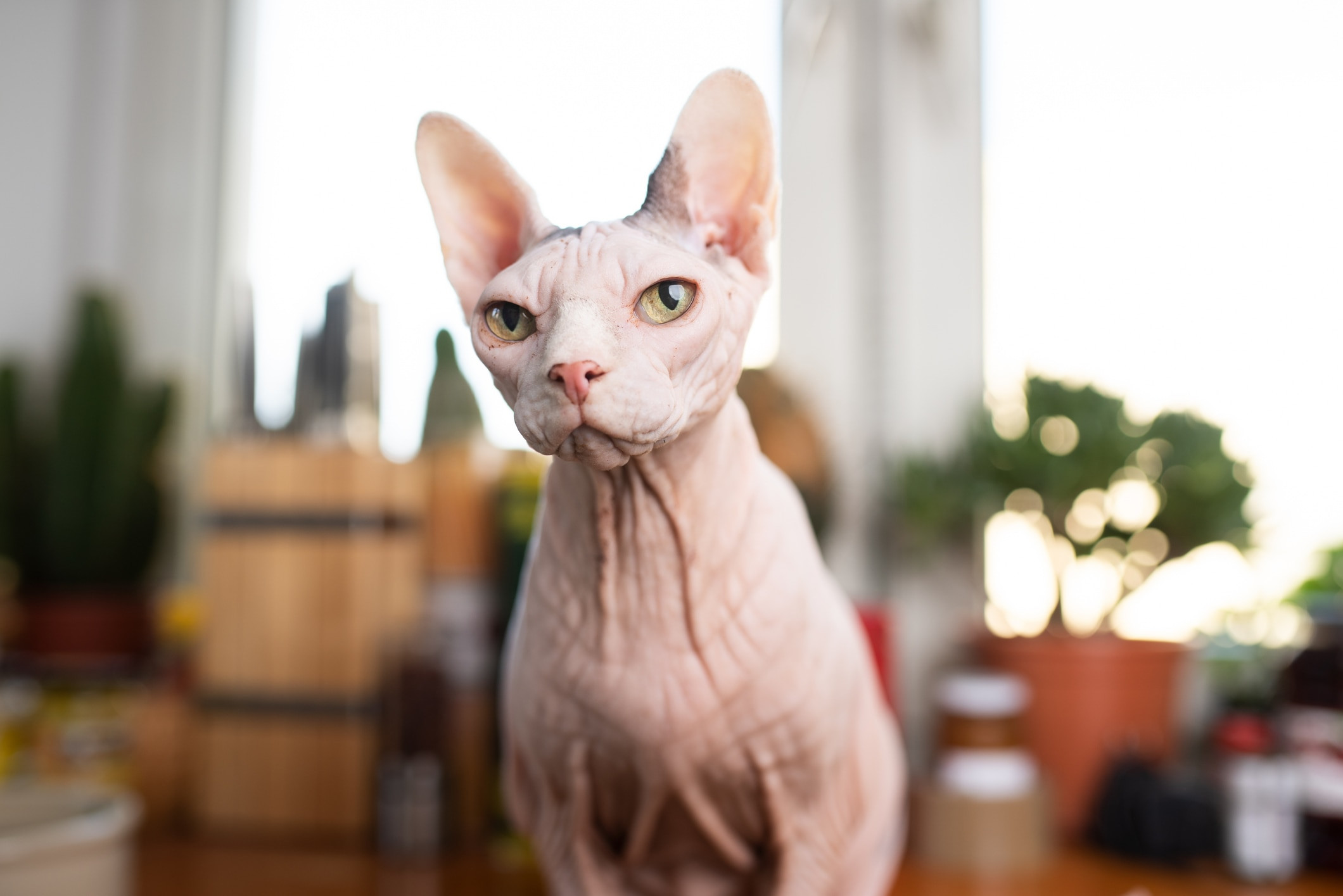 pink sphynx cat looking down at the camera in a living room
pink sphynx cat looking down at the camera in a living room
Photo credit: Nils Jacobi/iStock / Getty Images Plus via Getty Images
The Sphynx cat is perhaps the most recognized among cats with no hair. Despite appearances, they aren’t truly bald. Instead, their bodies are covered in a soft, downy fuzz that feels akin to chamois leather. This unique coat makes them wonderfully warm to the touch, perfect for cozy cuddles. April Arguin, a Sphynx breeder and founder of LiLNudists Cattery, aptly describes their skin as feeling like “chamois,” highlighting their inviting warmth.
Sphynx cats are known for their distinctive wrinkles, prominent cheekbones, large ears, and expressive eyes. While some may sport whiskers and eyebrows, others have a completely smooth face. Beyond their striking looks, Sphynx cats are renowned for their vocal nature and outgoing personalities. They are intelligent, curious, and deeply attached to their human families, often following them around the house and engaging in playful antics. Be prepared for a chatty companion, as Sphynx cats are known to be quite vocal, expressing themselves with a range of meows and purrs.
2. Bambino: The Short-Legged Hairless Wonder
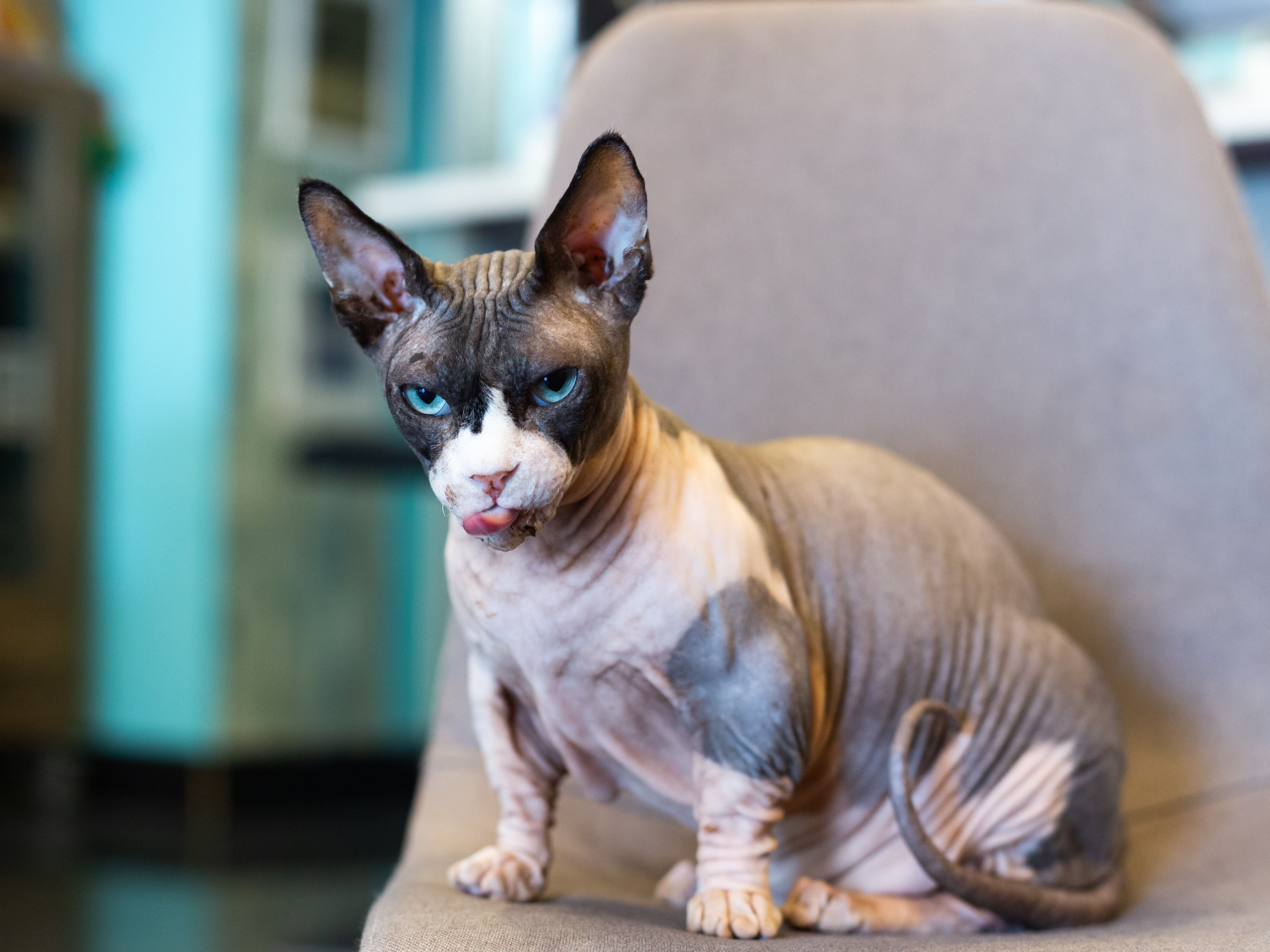 pink and gray bambino cat licking his lips
pink and gray bambino cat licking his lips
Photo credit: Adobe Stock/Anne Richard
The Bambino is a relatively new and captivating addition to the world of cats with no hair, having emerged in 2005. This breed is a deliberate cross between the hairless Sphynx and the short-legged Munchkin, resulting in a feline with a hairless body and adorably short legs. Currently considered an “experimental breed” by the Cat Fanciers Association, the Bambino is gaining popularity for its unique appearance and affectionate temperament.
Bambino cats are known for their playful and people-oriented nature. They thrive on interaction and crave attention from their human companions. Arguin emphasizes their deep desire for human connection, suggesting that they flourish best in homes where they receive plenty of love and playtime. Due to their social nature, adopting two Bambinos can be a wonderful idea to ensure they have constant companionship. However, owning a Bambino comes with a significant financial commitment; these unique felines can range in price from $2,000 to $2,800. Prospective owners should also be aware that their short legs can predispose them to joint problems.
3. Peterbald: The Elegant and Energetic Hairless Cat
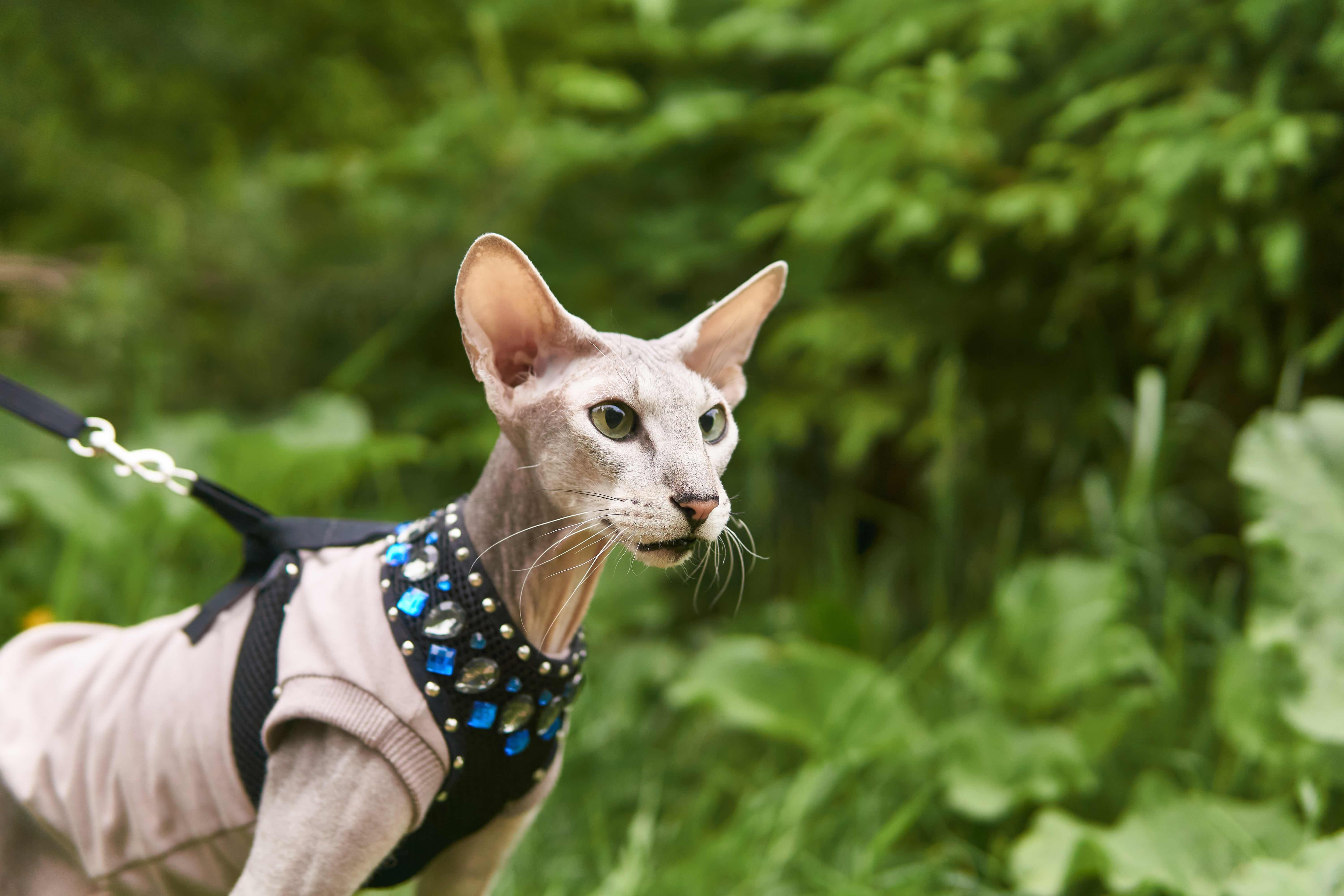 gray peterbald cat wearing a sweater on a leash
gray peterbald cat wearing a sweater on a leash
Photo credit: Adobe Stock/Evgeny
Originating from Russia, the Peterbald is a breed of cats with no hair characterized by its elegant, slender build and, most notably, its large, prominent ears. These ears, seemingly too large for their wedge-shaped heads, give them an alert and inquisitive expression. Peterbalds are known for their friendly and energetic personalities. They are intelligent and playful cats who enjoy interactive games like fetch and have a tendency to shadow their owners, following them from room to room.
One of the fascinating aspects of the Peterbald breed is the variety in their coats, or lack thereof. They can range from completely hairless to possessing a fuzzy coat, a curly coat, or even a wiry coat of varying lengths. Some Peterbalds might even develop a short or long coat similar to typical domestic cats, showcasing the diverse genetic expressions within the breed. While rarer outside of Russia, their charming personality and unique appearance make them sought-after companions.
4. Donskoy: A Variety of Hairless Coats
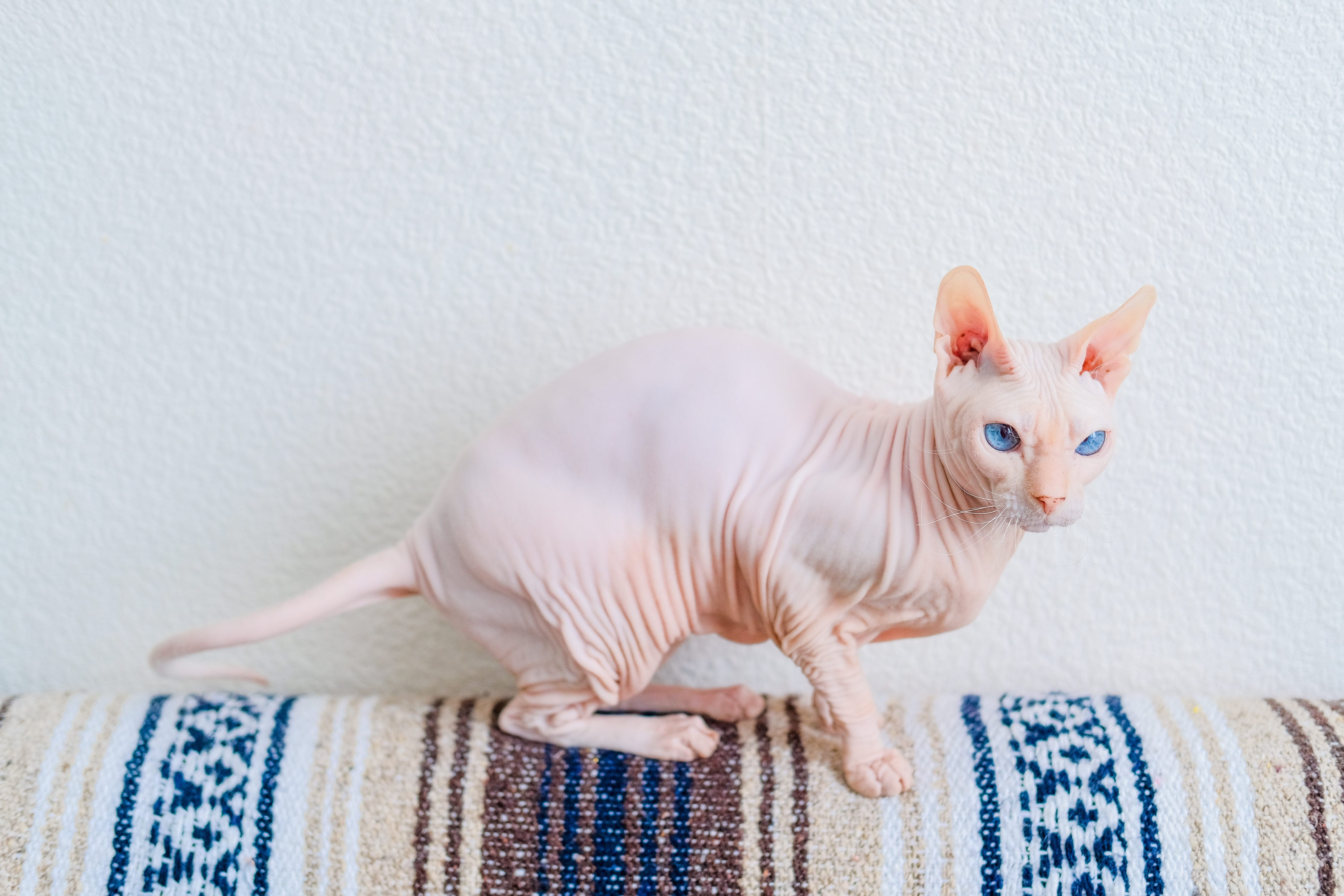 pink hairless cat with blue eyes perched on the back of a couch
pink hairless cat with blue eyes perched on the back of a couch
Photo credit: Adobe Stock/yolya_ilyasova
The Donskoy, another Russian breed of cats with no hair (sometimes spelled Don Sphynx or Donskoy Sphynx), presents an intriguing spectrum of hairlessness. Unlike the Sphynx, whose hairlessness is caused by a recessive gene, the Donskoy’s hairlessness is dominant, leading to diverse coat variations within the breed. There are four recognized types of Donskoy coats:
- Rubber Bald: These Donskoy cats are born completely hairless and remain so throughout their lives, possessing a smooth, rubber-like skin texture.
- Flocked: Born with a very fine, downy coat resembling peach fuzz, flocked Donskoys may or may not retain this fuzz as they mature, with some eventually becoming entirely bald.
- Velour: Velour Donskoys are born with a noticeable bald patch on the top of their heads, which may expand as they age.
- Brush: Brush Donskoys have a wiry, sparse coat that may include bald patches. This coat type is often considered less desirable for show purposes.
Beyond their coat variations, Donskoys are known for their sweet and intelligent nature. They are often described as friendly, affectionate, and adaptable, making them excellent family pets, even in households with children and other animals. Their playful and curious personalities make them engaging companions.
5. Lykoi: The “Werewolf Cat” With a Sparse Coat
 gray lykoi cat lying on his side and looking at the camera
gray lykoi cat lying on his side and looking at the camera
Photo credit: Angela Emanuelsson/iStock / Getty Images Plus via Getty Images
The Lykoi cat, often nicknamed the “werewolf cat” due to its unique appearance, is a relatively new breed that stands out among cats with no hair. Their sparse coat is a result of a natural genetic mutation, giving them a distinctive roan pattern where some areas of fur are present while others are bare, particularly around the face, eyes, and nose, enhancing their wolf-like resemblance. Lykois are known for “wolfing out,” a phenomenon where they molt a significant portion of their already sparse coat periodically, further emphasizing their unique look.
Despite their somewhat wild appearance, Lykoi cats are known for their affectionate and playful personalities. When they do have fur, it is remarkably soft, making cuddle sessions with these unique felines especially enjoyable. Owning a Lykoi, with their striking appearance and endearing personality, comes at a premium. Lykoi kittens typically start at around $1,000, reflecting their rarity and desirability.
6. Ukrainian Levkoy: Folded Ears and Hairlessness
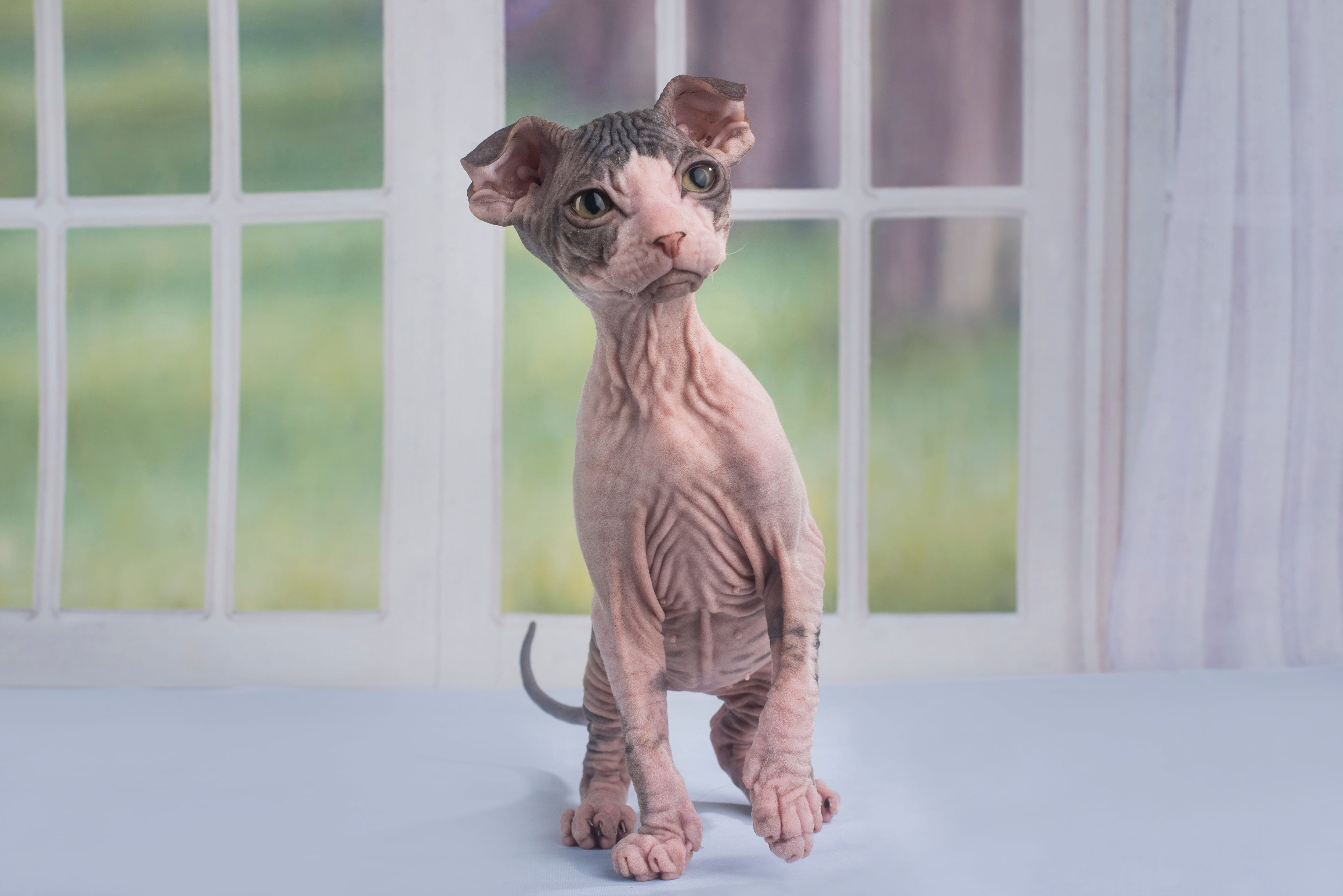 hairless ukrainian levkoy kitten standing in front of a window backdrop
hairless ukrainian levkoy kitten standing in front of a window backdrop
Photo credit: Adobe Stock/Светлана Валуйская
The Ukrainian Levkoy is a distinctive and relatively recent breed of cats with no hair, established in 2004 in Ukraine. What sets them apart, besides their hairlessness, are their folded ears, a trait they share with their close relative, the Scottish Fold. This combination of hairlessness and folded ears creates a truly unique and striking appearance.
As a newer breed, the long-term health of Ukrainian Levkoys is still being studied. However, their lineage to the Scottish Fold raises concerns about potential joint and cartilage problems, conditions known to affect Scottish Folds. While folded ears are a highly sought-after trait in this breed, commanding a higher price (reaching up to $2,000 per kitten), not all Ukrainian Levkoys inherit the folded ear gene. Regardless of their ear type, Ukrainian Levkoys are generally described as stoic and gentle cats. They tend to be quiet companions who appreciate the presence of others, often enjoying companionship without being overly demanding of attention.
Essential Care for Your Cat With No Hair
Bringing a cat with no hair into your family brings unique joys and responsibilities. Their lack of fur makes them more vulnerable to certain environmental factors and necessitates specific care adjustments.
One crucial aspect of caring for cats with no hair is sun protection. Their exposed skin is susceptible to sunburn. Just like humans, they can suffer skin damage from prolonged sun exposure. To protect them, consider using pet-safe sunscreen on exposed areas, especially ears and nose, and install UV-blocking window films in your home.
Temperature regulation is another key consideration. Without a fur coat, these breeds are more sensitive to both heat and cold. In summer, provide cooling mats and ensure access to shaded areas to prevent overheating. In winter, cozy sweaters and warm bedding are essential to keep them comfortable and prevent them from getting chilled.
Skin care is paramount for cats with no hair. Their skin produces oils that would normally be absorbed by fur, leading to a slightly greasy feel. While frequent full baths can dry out their skin, regular wipe-downs with a damp cloth can help manage oil buildup. Consult your veterinarian about a suitable skincare routine, which might include occasional baths with specialized, moisturizing cat shampoos to replenish their skin’s natural oils.
Finally, ear and nail hygiene often requires more attention in cats with no hair. They tend to accumulate more ear wax and oil on their skin, so more frequent ear cleaning is necessary. Similarly, their nails may also require more frequent trimming.
While cats with no hair may need a bit more specialized care than their furry counterparts, their unique charm, affectionate personalities, and engaging nature make them incredibly rewarding companions for dedicated owners.
Frequently Asked Questions About Cats With No Hair
Are cats with no hair hypoallergenic?
Despite the common misconception, no cat breed is truly hypoallergenic. The allergens that trigger reactions are found in cat saliva, urine, and dander, not primarily in their fur. However, cats with no hair are often considered among the best cat breeds for people with allergies. This is because they produce less dander, the tiny skin flakes that carry allergens, which can reduce the amount of allergens circulating in the environment. If you have allergies, it’s always wise to consult with your doctor about allergy management strategies before bringing any cat, including a hairless breed, into your home.
What is the average cost of cats with no hair?
Due to their relative rarity and specialized breeding, cats with no hair generally come with a higher price tag than many other breeds. You can typically expect to pay between $1,000 and $2,000 for a hairless kitten. Finding them in animal shelters is uncommon, but there are specialized rescue organizations that focus on specific breeds, including hairless cats. Exploring breed-specific rescues can be a rewarding path to adoption.
Are cats with no hair known to be friendly?
The temperament of any cat, including cats with no hair, is significantly influenced by their socialization experiences as kittens. Early and positive exposure to people, other animals, and various environments plays a crucial role in shaping their personality. When properly socialized and raised with positive reinforcement, cats with no hair are known to be just as loving, affectionate, and friendly as any other cat breed. Their close bond with their owners is a hallmark of many hairless breeds.
WRITTEN BY
Janelle Leeson
Freelance Writer
